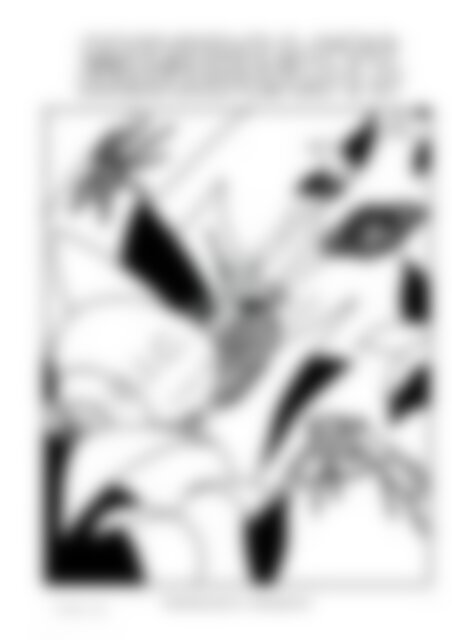RIC-0399 Minibeasts
Create successful ePaper yourself
Turn your PDF publications into a flip-book with our unique Google optimized e-Paper software.
©R.I.C. Publications<br />
Low Resolution Images<br />
Display Copy<br />
<strong>RIC</strong>-<strong>0399</strong> 4.1/513<br />
Published by R.I.C. Publications
F oreword<br />
<strong>Minibeasts</strong> are all around us! The species have existed on the<br />
Earth for millions of years. This is a fascinating theme that will<br />
capture the interest and imaginations of the children in your class.<br />
<strong>Minibeasts</strong> lends itself to an across-the-curriculum theme. It enables teachers to<br />
integrate learning tasks from all subject areas and hence promote a more extensive<br />
knowledge of the topic to students. Providing living examples of the kinds of creatures<br />
children will be learning about will enable teachers to program many hands-on, sciencebased<br />
activities. In this blackline master set, minibeasts include insects, arachnids, worms<br />
and some crustaceans - the types of animals that are suitable to keep in a classroom<br />
environment. This theme package provides teachers with resources to focus learning and<br />
ideas to instill further extension of the topic within your class.<br />
Enjoy teaching the world of <strong>Minibeasts</strong>!<br />
Contents<br />
Theme Ideas .................................................... ii<br />
Clip Art ............................................................ iii<br />
Contract.......................................................... iv<br />
Student Record Sheet................................. v<br />
Cover Page....................................................... vi<br />
Language<br />
Identifying <strong>Minibeasts</strong>...................................1<br />
Did You Know? ................................................ 2<br />
What Am I? ..................................................... 3<br />
Adjectives and Verbs ................................... 4<br />
Compound Words and Homonyms ........... 5<br />
Minibeast Word Puzzle................................. 6<br />
Describe a Minibeast ....................................7<br />
Creature Crosspatch................................... 8<br />
Legend of Arachne........................................ 9<br />
Phobias and Endangered Species ..........10<br />
An Ant Colony................................................ 11<br />
Amazing Arachnids ..................................... 12<br />
Life Cycles - 1 and 2 ............................13 - 14<br />
Biology International - 1 and 2........ 15 - 16<br />
Minibeast Acrostic Poems ........................ 17<br />
Butterfly Discovery .....................................18<br />
An Unsolved Mystery .................................19<br />
Ugly Bug Invitation .................................... 20<br />
Make a Minibeast ........................................ 21<br />
Minibeast Matching Game ...................... 22<br />
Mathematics<br />
Measuring <strong>Minibeasts</strong>...............................23<br />
Pick the Pattern ..........................................24<br />
Minibeast Maths Puzzlers ....................... 25<br />
Symmetry .................................................... 26<br />
Science<br />
Minibeast Classification........................... 27<br />
Minibeast Observation ............................. 28<br />
<strong>Minibeasts</strong> Up Close ..................................29<br />
Investigating Snails .................................. 30<br />
Health<br />
©R.I.C. Publications<br />
Low Resolution Images<br />
Display Copy<br />
Spider Alert! - First Aid ............................ 31<br />
Studies of Society and the Environment<br />
Where in the World?....................................32<br />
Project - <strong>Minibeasts</strong> ................................. 33<br />
Answers........................................................ 34<br />
R.I.C. Publications - <strong>Minibeasts</strong><br />
www.ricgroup.com.au<br />
i
T heme Ideas<br />
• Ants, snails, silkworms, earthworms<br />
and mealworms are all suitable to<br />
keep in the classroom for<br />
observation.<br />
• Write a fictional story titled…<br />
'Trapped in the land of the<br />
<strong>Minibeasts</strong>.'<br />
• Organise a visit to the zoo or museum<br />
to see the insect displays.<br />
• Write a daily diary to record<br />
observations of the minibeasts being<br />
kept in the classroom.<br />
• Make a 'Did you know?' big book for<br />
children to read in class. Include<br />
unusual pieces of information that<br />
children find in books.<br />
• Create a class wall<br />
mural with as many<br />
different minibeasts as<br />
possible.<br />
• Find out about the types of minibeasts<br />
that live in the desert, the rainforest<br />
and the water.<br />
• Make minibeast bookmarks showing the<br />
children's favourite creatures.<br />
• Study<br />
minibeasts<br />
that use<br />
camouflage as<br />
a form of<br />
defence.<br />
©R.I.C. Publications<br />
Low Resolution Images<br />
Display Copy<br />
• Compile a list of the ways<br />
insects have helped humans<br />
and the environment.<br />
• Set up a 'Minibeast of the Week'<br />
display - examples/books; collect<br />
information and pictures;<br />
children can record interesting<br />
facts on shaped cards.<br />
• At the conclusion of the topic,<br />
hold a 'Minibeast Quiz Day'.<br />
Think of interesting minibeast<br />
prizes.<br />
• Drama - move like different<br />
minibeasts; demonstrate a<br />
butterfly's life cycle; attack<br />
predators.<br />
• Make a minibeast jigsaw.<br />
Give it to a friend to solve.<br />
R.I.C. Publications - <strong>Minibeasts</strong><br />
ISBN 978-1-86311-498-1<br />
www.ricgroup.com.au<br />
ii
C lip Art<br />
©R.I.C. Publications<br />
Low Resolution Images<br />
Display Copy<br />
R.I.C. Publications - <strong>Minibeasts</strong><br />
ISBN 978-1-86311-498-1<br />
www.ricgroup.com.au<br />
iii
C ontract<br />
When I have filled the leaves with ladybugs, my reward will be…<br />
1.<br />
2.<br />
3.<br />
To earn a ladybug, I must:<br />
©R.I.C. Publications<br />
Low Resolution Images<br />
Display Copy<br />
R.I.C. Publications - <strong>Minibeasts</strong><br />
ISBN 978-1-86311-498-1<br />
www.ricgroup.com.au<br />
iv
Page<br />
R ecord Sheet<br />
Page<br />
Title<br />
1 Identifying <strong>Minibeasts</strong><br />
2 Did You Know?<br />
3 What Am I?<br />
4 Adjectives and Verbs<br />
5 Compound Words and Homonyms<br />
6 Minibeast Word Puzzle<br />
7 Describe a Minibeast<br />
8 Creature Crosspatch<br />
9 Legend of Arachne<br />
10<br />
Phobias and Endangered Species<br />
11<br />
An<br />
Ant Colony - Cloze<br />
12<br />
Amazing<br />
Arachnids - Cloze<br />
13/14<br />
Life<br />
Cycles 1 & 2 -<br />
Comprehension<br />
15/16<br />
Biology<br />
International 1 & 2 -<br />
17<br />
Minibeast Acrostic Poems<br />
18<br />
Butterfly Discovery<br />
19<br />
An Unsolved Mystery<br />
20<br />
Ugly Bug Invitation<br />
21<br />
Make<br />
a Minibeast - Procedure<br />
Comprehension<br />
22<br />
Minibeast<br />
Matching Game - Oral Language<br />
23<br />
Measuring <strong>Minibeasts</strong><br />
24<br />
Pick the Pattern<br />
25<br />
Minibeast Maths Puzzlers<br />
26<br />
Symmetry<br />
27<br />
Minibeast Classification<br />
28<br />
Minibeast Observation<br />
29<br />
<strong>Minibeasts</strong> Up Close<br />
30<br />
Investigating Snails<br />
31<br />
Spider Alert! - First Aid<br />
32<br />
Where in the World?<br />
33<br />
Project - <strong>Minibeasts</strong><br />
Complete<br />
Comment<br />
©R.I.C. Publications<br />
Low Resolution Images<br />
Display Copy<br />
R.I.C. Publications - <strong>Minibeasts</strong><br />
ISBN 978-1-86311-498-1<br />
www.ricgroup.com.au<br />
v
I would like to learn the following things about minibeasts…<br />
©R.I.C. Publications<br />
Low Resolution Images<br />
Display Copy<br />
R.I.C. Publications - <strong>Minibeasts</strong><br />
ISBN 978-1-86311-498-1<br />
www.ricgroup.com.au<br />
vi
I dentifying <strong>Minibeasts</strong><br />
Not all minibeasts or creepy-crawly things are insects.<br />
Find the definition of an 'insect' in the dictionary.<br />
Are spiders insects?<br />
Are snails insects?<br />
Brainstorm all the insects and other minibeasts you can think of, then<br />
share ideas with your classmates and add to your list.<br />
Look in books to find illustrations and information about various minibeasts.<br />
Choose four and draw them.<br />
1 .<br />
2 .<br />
3 .<br />
4.<br />
©R.I.C. Publications<br />
Low Resolution Images<br />
Display Copy<br />
Write their names onto the semantic grid and complete the chart.<br />
Name<br />
Number<br />
Legs<br />
of<br />
Number of<br />
body parts.<br />
Is it an<br />
insect?<br />
Does it<br />
have wings?<br />
Lives above or<br />
below ground.<br />
1.<br />
2.<br />
3.<br />
4.<br />
R.I.C. Publications - <strong>Minibeasts</strong> www.ricgroup.com.au<br />
1<br />
ISBN 978-1-86311-498-1
D id You Know?<br />
Use these words to fill in the missing spaces and learn some interesting<br />
facts about minibeasts.<br />
sleep, grow, mouths, wings, Australia,<br />
diseases, antennae, horned, individual, hive, sand, nocturnal<br />
Millipedes rely on their<br />
to feel where they are going.<br />
Earwigs curl up in groups to<br />
3<br />
for the winter.<br />
They hunt at night.<br />
There are three kinds of<br />
honeybees that live together<br />
7<br />
in a<br />
- the<br />
queen, drone (male) and<br />
worker bees.<br />
Mosquitoes are a type of fly<br />
which live and breed in warm, wet<br />
places. They can carry<br />
like malaria and Ross River Virus.<br />
9<br />
2<br />
Three types of fly found in<br />
bush fly and house fly.<br />
Scorpions are<br />
An earthworm can<br />
up to 30 cm long.<br />
Short- 11<br />
grasshoppers are also called locusts.<br />
Dragonflies have two large 'compound' eyes<br />
that are each made up of thousands of tiny<br />
eyes. This allows them to see in all<br />
directions.<br />
5<br />
animals.<br />
10<br />
Beetles use their<br />
4<br />
are the fruit fly,<br />
in a biting action and bugs<br />
have mouths like needles.<br />
©R.I.C. Publications<br />
Low Resolution Images<br />
Display Copy<br />
Two differences<br />
between moths and<br />
butterflies are:<br />
1. Butterflies fly during the day, moths usually fly at night.<br />
2. A moth rests with its<br />
8<br />
open,<br />
but a butterfly rests with its wings closed.<br />
The ant-lion lives in<br />
1<br />
12<br />
and makes traps for<br />
ants to fall into.<br />
6<br />
R.I.C. Publications - <strong>Minibeasts</strong> www.ricgroup.com.au<br />
2<br />
ISBN 978-1-86311-498-1
W hat Am I?<br />
1.<br />
Read the clues to identify the mystery minibeasts. Draw a detailed picture<br />
of each.<br />
4.<br />
2.<br />
3.<br />
I am a type of beetle.<br />
My bright colours warn enemies to stay away.<br />
If I am attacked, I ooze vile-tasting, sticky,<br />
yellow blood from my knees.<br />
I am red with black spots.<br />
I am a<br />
I am usually 3 to 4 cm long.<br />
My first pair of legs are fangs.<br />
Some of my kind have up to 125 pairs of legs.<br />
My body is made up of many segments.<br />
I am a<br />
5.<br />
6.<br />
I have a poisonous bite, but it is not always<br />
dangerous to people.<br />
I get rid of insect pests in peoples' homes.<br />
I have more than six legs.<br />
I am a<br />
I am a wingless insect.<br />
I have large hind legs for jumping.<br />
I live on other animals.<br />
I am a nuisance to pets.<br />
I am a<br />
©R.I.C. Publications<br />
Low Resolution Images<br />
Display Copy<br />
I catch prey with my long, powerful front legs.<br />
I have a slender body that looks like part of a<br />
leaf.<br />
When I rest, I look like I am praying.<br />
I lay thousands of eggs in my lifetime.<br />
I can use my sting many times over.<br />
I am the leader of a group called a swarm.<br />
I am a<br />
I am a<br />
Choose two different minibeasts and write your own 'What am I?' puzzles.<br />
Ask your friends to try and identify your mystery creatures.<br />
(Remember to write the easiest clue last!)<br />
R.I.C. Publications - <strong>Minibeasts</strong> www.ricgroup.com.au<br />
3<br />
ISBN 978-1-86311-498-1
A djectives and Verbs<br />
Adjectives are describing words; for example, tiny and smooth.<br />
Write adjectives that describe these minibeasts.<br />
beetle butterfly worm spider<br />
1.<br />
Add adjectives to complete this string writing activity.<br />
Moths, moths, moths<br />
Moths, moths, moths<br />
Ants, ants, ants<br />
, , moths , , ants<br />
, , moths , , ants<br />
Read your string poem to the class.<br />
Ants, ants, ants<br />
Verbs are action or doing words; for example, run and hear.<br />
Think of doing words that describe the actions of different minibeasts.<br />
List them here.<br />
Put three of these verbs into sentences about a minibeast.<br />
©R.I.C. Publications<br />
Low Resolution Images<br />
Display Copy<br />
2.<br />
3.<br />
Underline the verbs in the sentence below.<br />
Most insects live on or near plants. Plants give them<br />
food and shelter. Some insects even look similar to<br />
parts of a plant. Others can change their appearance<br />
to match their surroundings. They use camouflage to<br />
protect themselves from predators.<br />
Challenge - These words describe groups of animals.<br />
A colony of ants, a swarm of bees and a plague of<br />
locusts. Can you think of any others?<br />
Colour this moth so it<br />
looks like the tree bark.<br />
R.I.C. Publications - <strong>Minibeasts</strong> www.ricgroup.com.au<br />
4<br />
ISBN 978-1-86311-498-1
C ompound Words and Homonyms<br />
Join two small words together to form compound words.<br />
(They are all names of minibeasts.)<br />
Put them into alphabetical order.<br />
lady<br />
hopper<br />
bed<br />
wood<br />
fire<br />
bird<br />
fly<br />
lace<br />
bug<br />
fish<br />
lice<br />
wing<br />
wig<br />
silver<br />
grass<br />
ear<br />
Compound<br />
Words<br />
1 .<br />
1.<br />
2 .<br />
2.<br />
3 .<br />
3.<br />
4 .<br />
4.<br />
5 .<br />
5.<br />
6 .<br />
6.<br />
7 .<br />
7.<br />
8 .<br />
8.<br />
Alphabetical Order<br />
Homonyms are words that sound the same but are spelt differently<br />
and have different meanings.<br />
Choose the correct homonym for each sentence.<br />
1. The ants disappeared into a .<br />
2. The caterpillar had spiky tufts of on<br />
its colourful body.<br />
3. A bee lands on each bright in search<br />
of pollen.<br />
4. In many spider species, the spiders<br />
are much smaller than the females.<br />
5. A centipede is a carnivore or -eater.<br />
6. Some creatures catch their in traps.<br />
1.<br />
2.<br />
3.<br />
4.<br />
Put four of the homonyms you didn't use into sentences.<br />
(Remember capital letters and full stops.)<br />
meat<br />
meet<br />
R.I.C. Publications - <strong>Minibeasts</strong> www.ricgroup.com.au<br />
5<br />
ISBN 978-1-86311-498-1<br />
hare<br />
hole<br />
pray<br />
flower<br />
mail<br />
hair<br />
whole<br />
©R.I.C. Publications<br />
Low Resolution Images<br />
Display Copy<br />
prey<br />
flour<br />
male
M inibeast Word Puzzle<br />
Use the clues to find the answer in these word puzzles.<br />
(A= across, D= down)<br />
1 .<br />
3.<br />
1 .<br />
3.<br />
1 .<br />
3.<br />
1A live in a hive 1A Flat is one type 1A A jumping insect<br />
1D A variety of fly<br />
1D Has a sting in its tail 1D Used to bite<br />
Beetles have four 2A Silverfish on the s 2A Earthworms tunnel in<br />
s<br />
of a book<br />
A snail with no shell 3D Wriggle, walk, hop 3D Ladybirds eat s<br />
Unjumble these minibeast words. (Some are creature names, others are body<br />
parts.) Locate them in the word sleuth.<br />
2A<br />
3D<br />
2.<br />
eey wotheramr eetbel<br />
gle nlais shilvfersi<br />
ateannn<br />
2.<br />
tekccri<br />
eeb hpida cacadi<br />
orniopsc<br />
lyf<br />
angfs<br />
ahed<br />
wja<br />
gbu<br />
ouhmt<br />
dombena<br />
nioatnl<br />
pdeellmii<br />
ngwi<br />
©R.I.C. Publications<br />
Low Resolution Images<br />
Display Copy<br />
A A A A E Y E A A A<br />
A A D R A G O N F L Y A A A<br />
A A H T U O M R O W H T R A E A<br />
A N T E N N A B D O M E N A A A<br />
S E T B E E H S I F R E V L I S A<br />
L N L I A N S C O R P I O N F L Y<br />
Z R I M I L L I P E D E G N I T S<br />
A O O A D A C I C R I C K E T W A<br />
A H N H O R N E T T E L T E E B A<br />
A A A P H I D G E L F A N G S A A<br />
A A H E A D W I N G U B A A A<br />
A A J A W L A A A A A A<br />
R.I.C. Publications - <strong>Minibeasts</strong> www.ricgroup.com.au<br />
6<br />
ISBN 978-1-86311-498-1<br />
2.<br />
thorne<br />
noragfydl
D escribe a Minibeast<br />
Write brief descriptions and interesting facts about a minibeast that...<br />
…lives underground.<br />
Name:<br />
…is poisonous (to humans).<br />
Name:<br />
Description:<br />
Description:<br />
…can fly (to search for food).<br />
Name:<br />
Description:<br />
©R.I.C. Publications<br />
Low Resolution Images<br />
Display Copy<br />
…lays eggs (on a plant).<br />
Name:<br />
Description:<br />
R.I.C. Publications - <strong>Minibeasts</strong> www.ricgroup.com.au<br />
7<br />
ISBN 978-1-86311-498-1
C reature Crosspatch<br />
Write these creatures names on the grid according to the number of letters<br />
in their names.<br />
wasp, slater, tick, mosquito, lice, caterpillar, flea, locust, cockroach,<br />
spider, slug, silkworm, grasshopper, moth, centipede, earwig, mite, glowworm, beetle<br />
4 letters 6 letters 8 letters 9 letters<br />
11 letters<br />
Now place the names onto the crosspatch so they all fit together. All words<br />
go down or across (ie. not backwards).<br />
©R.I.C. Publications<br />
Low Resolution Images<br />
Display Copy<br />
R.I.C. Publications - <strong>Minibeasts</strong> www.ricgroup.com.au<br />
8<br />
ISBN 978-1-86311-498-1
L egend of Arachne<br />
The scientific name for the group of creatures that spiders<br />
belong to is 'Arachnida' - spiders are one type of arachnid. The<br />
ancient Greek name for spider is 'arachne'.<br />
The name Arachnida originates from an ancient Greek legend.<br />
Read the Greek legend.<br />
Once there was a young girl named Arachne. She was very clever at spinning and<br />
weaving beautiful tapestries. She told the people in her village that she was<br />
better at spinning than the goddess, Athena. So Athena challenged Arachne to<br />
a contest. When Athena saw Arachne's beautiful work, she became very angry.<br />
She ripped the cloth and beat the girl. Arachne was disgraced and hanged<br />
herself. Athena felt so guilty that she sprinkled magic dust on the girl's body<br />
and changed her into a spider so she could spin for ever and ever.<br />
Choose three important events from the story and illustrate them.<br />
©R.I.C. Publications<br />
Low Resolution Images<br />
Display Copy<br />
These minibeasts also have names associated with Greek mythology. Find<br />
out about these creatures famous namesakes.<br />
1. Hercules - beetle<br />
2. Ulysses - butterfly<br />
R.I.C. Publications - <strong>Minibeasts</strong> www.ricgroup.com.au<br />
9<br />
ISBN 978-1-86311-498-1
P hobias and Endangered Species<br />
A phobia is an intense, irrational fear of certain things or situations.<br />
For example, 'arachnophobia' is a fear of spiders.<br />
Find out what people with these phobias fear.<br />
1. acrophobia 2. agoraphobia<br />
3. claustrophobia 4. cynophobia<br />
5. bacteriophobia 6. haemophobia<br />
How do you think you could help somebody overcome a fear of spiders?<br />
Most small creatures do not need to be feared, as they are not harmful to man and those<br />
which are, often only become so when provoked. There are many minibeasts which actually<br />
help humans and the environment. Can you think of some? We should value all living things<br />
and ensure they will always be part of our world. Did you know that even though arthropods<br />
are the most successful group of animals to have evolved on Earth, some species today<br />
are listed as rare or endangered?<br />
The large Homerus Swallowtail Butterfly, found<br />
only in Jamaica, is now an endangered species<br />
because it is so popular with butterfly collectors.<br />
Other animals' survival can be dependant on<br />
changes to its environment - if their food supply<br />
decreases or living conditions are altered, their<br />
numbers can decline.<br />
Design two badges that show your favourite insects. Keep one and give the<br />
other to a friend in another class.<br />
Have a special 'Insect<br />
Awareness Day' - wear<br />
your badge and visit<br />
other classes to<br />
explain the<br />
importance of insects<br />
in our world.<br />
I Love<br />
In s e cts<br />
Spiders<br />
H e<br />
lp<br />
U s<br />
©R.I.C. Publications<br />
Low Resolution Images<br />
Display Copy<br />
Sw a<br />
Save the<br />
llo w ta<br />
Find out about other endangered species.<br />
il<br />
• Cut out and glue your design onto<br />
a cardboard circle and attach a<br />
pin.<br />
R.I.C. Publications - <strong>Minibeasts</strong> www.ricgroup.com.au<br />
10<br />
ISBN 978-1-86311-498-1
A n Ant Colony<br />
larvae store<br />
Read the following passage and put in the missing words.<br />
food, build, thousand, work, nest, ant, bigger, groups, eggs, Inside, die, rooms, lays<br />
Ants live in large<br />
can be several<br />
underground.<br />
of<br />
like a mound above the ground; others<br />
called colonies. They build their own homes - there<br />
ants in one nest. Some ants build a<br />
each nest are many tunnels and little<br />
their home<br />
called chambers. Each chamber has a different purpose. Three types<br />
live in the nest and they all have different jobs to do.<br />
1. The queen ant is than the other ants in the nest. She<br />
eggs.<br />
2. Male ants do not in the nest. They mate with the queen and then<br />
.<br />
Worker ants build and guard the nest, gather<br />
look after the<br />
rubbish<br />
Queen in egg room<br />
, larvae and pupae.<br />
food store<br />
tunnelling<br />
, keep the nest clean and<br />
Find and observe ants in their natural environment.<br />
Can you work out where the ants are coming from and going to?<br />
Can you locate the entry to an ants' nest?<br />
How do the ants follow a trail?<br />
Are the ants carrying anything?<br />
What happens if you drop a few grains of sugar in the ants' path?<br />
See if you can find the answers to these questions to discuss when you<br />
return to your class. Write a brief recount of the experience.<br />
R.I.C. Publications - <strong>Minibeasts</strong> www.ricgroup.com.au<br />
11<br />
ISBN 978-1-86311-498-1<br />
cocoons<br />
©R.I.C. Publications<br />
Low Resolution Images<br />
Display Copy
A mazing Arachnids<br />
Use the topic words to complete the comprehension activity.<br />
trap, divided, living, million, grow, carry, victim, glands, live, eight, types<br />
carry, new, people, larger, backbone, little, back, sting, pincers, host<br />
Arachnids are a large group of animals that belong to the Arthropod (means joint-legged)<br />
family. The group includes spiders, scorpions, ticks and mites. They have<br />
legs and a hard external skeleton which cannot<br />
ones as they get bigger. Their bodies are<br />
parts; the head and thorax (which are joined together) and the abdomen.<br />
abdomen<br />
There are many different<br />
have several eyes but can see<br />
. So they moult and form<br />
into two<br />
of spiders. Spiders<br />
. They make silk in<br />
at the back of the abdomen. They use the silk<br />
in different ways, but mainly to make webs to<br />
their prey. Spiders eat insects and other small invertebrates<br />
(animals with no<br />
poisonous bite which can kill or paralyse their<br />
the juices out of the insect. Most spiders lay eggs. They help<br />
because they eat flies and other insect pests.<br />
Scorpions have lived on Earth for as long as 45<br />
years. Most species are not dangerous to people - they rarely<br />
attack, but can give a<br />
if threatened. They hunt for<br />
food (insects and spiders) at night and catch their prey with two<br />
large<br />
four legs on each side of body<br />
.) They have a<br />
. The spider then sucks<br />
. Scorpions use the sting in their tails, if the insect fights.<br />
Scorpions give birth to young, which are carried on their mother's .<br />
Ticks and Mites are very similar, but mites are<br />
less than 1 mm long! Most of them, are parasites (they live on or in other<br />
Ticks and mites can<br />
head<br />
and<br />
thorax<br />
©R.I.C. Publications<br />
Low Resolution Images<br />
Display Copy<br />
. Even so, mites are<br />
things). They use their mouths (like a beak with teeth) to hold onto<br />
animals and plants. Then they suck blood or other body fluids from the victim.<br />
diseases which affect humans.<br />
R.I.C. Publications - <strong>Minibeasts</strong> www.ricgroup.com.au<br />
12<br />
ISBN 978-1-86311-498-1
L ife Cycles - 1<br />
An animal's life cycle is the way it changes and grows from an egg to an adult.<br />
Insects like dragonflies and grasshoppers have a life cycle with three stages. Other<br />
insects, including butterflies, wasps, bees and ants, have life cycles with four stages.<br />
3. adult<br />
Dragonfly<br />
Butterfly<br />
- 3 stage life cycle - - 4 stage life cycle -<br />
1. eggs<br />
2. nymphs<br />
(larvae)<br />
1. The female dragonfly lays the eggs.<br />
She drops them onto the surface of a<br />
body of water or attaches them to a<br />
plant.<br />
2. The eggs hatch into young dragonflies<br />
called 'nymphs'. They live in the water<br />
and as they grow, they shed their skin<br />
many times.<br />
3. After a year or more, the nymphs climb<br />
out of the water and shed their skin<br />
for the last time. They will have<br />
developed wings and become adult<br />
dragonflies.<br />
4. adult<br />
3. pupa (chrysalis)<br />
2. caterpillar<br />
(larvae)<br />
1. The female butterfly lays eggs on a<br />
plant, which will be food for the young<br />
when they hatch.<br />
2. From the eggs, hatch larvae called<br />
caterpillars. The hungry caterpillars<br />
eat the empty egg shells.<br />
3. The caterpillars find a place to rest<br />
and then spin a cocoon made from silk.<br />
It then becomes a pupa or chrysalis.<br />
Inside the cocoon, the pupae grow and<br />
change into insects.<br />
4. When the case opens, a butterfly<br />
emerges.<br />
1. eggs<br />
©R.I.C. Publications<br />
Low Resolution Images<br />
Display Copy<br />
R.I.C. Publications - <strong>Minibeasts</strong> www.ricgroup.com.au<br />
13<br />
ISBN 978-1-86311-498-1
L ife Cycles - 2<br />
Read the article and answer the following questions.<br />
1. Write 'fact' or 'fiction' next to each statement using information from the text.<br />
a Inside each cocoon, a nymph grows and changes.<br />
b Some female dragonflies lay eggs on the surface of a pond or stream.<br />
c Caterpillars shed their skin to become a pupa.<br />
2. Larvae are young animals that hatch from eggs. True / False<br />
3. Pupae spin cases called cocoons around themselves. True / False<br />
4. Write a word with a similar meaning from the article.<br />
a moult<br />
c named<br />
5. Why would a butterfly lay its eggs on a leaf?<br />
6. Why do dragonfly nymphs shed their skin?<br />
7. a What is a 'life cycle'?<br />
b Why do you think it is called a cycle?<br />
b top<br />
d steps<br />
©R.I.C. Publications<br />
Low Resolution Images<br />
Display Copy<br />
8. Name two insects (other than a butterfly) with a four<br />
stage life cycle.<br />
9. A grasshopper's life cycle has three stages. Do you think that (like dragonflies),<br />
grasshopper nymphs would live in the water? Yes / No<br />
Why? Why Not?<br />
10. On the back of this page write words that describe how you would feel if you were a<br />
butterfly coming out of a cocoon.<br />
R.I.C. Publications - <strong>Minibeasts</strong> www.ricgroup.com.au<br />
14<br />
ISBN 978-1-86311-498-1
B iology International - 1<br />
- An Introduction to Beetles -<br />
June Issue 197<br />
Beetles, like all insects, have<br />
three main body parts - the<br />
head, the thorax and the<br />
abdomen. Its body is<br />
protected by a hard, often<br />
shiny covering like armour.<br />
This hard case is one form<br />
of defence against enemies.<br />
On the head are antennae<br />
and palps, which are used<br />
for smelling and feeling, two<br />
eyes and its jaws. The<br />
thorax contains the muscles<br />
which control the beetle's<br />
three pairs of legs and two<br />
pairs of wings. Almost all<br />
Diagram of a beetle<br />
beetles can fly. The beetle's<br />
front wings are folded back<br />
over the rear wings, which<br />
are used to fly. The abdomen<br />
contains the insect's<br />
digestive, respiratory and<br />
reproductive systems. The<br />
beetle breathes through<br />
airholes in the sides of its<br />
abdomen.<br />
Many ground beetles are<br />
rarely seen because they<br />
come out at night to hunt.<br />
There are several kinds of<br />
beetles which can live<br />
underwater. Some beetles<br />
are helpful to man because<br />
they help keep the number<br />
of pests down. Others can<br />
be a nuisance as they<br />
damage trees and plants.<br />
Most beetles are<br />
vegetarians; many are<br />
scavengers (they feed on<br />
what other animals have<br />
left behind). Some beetles<br />
produce chemicals that are<br />
foul smelling or tasting, or<br />
actually harm the attacker<br />
as another form of defence.<br />
©R.I.C. Publications<br />
Low Resolution Images<br />
Display Copy<br />
Label this diagram.<br />
abdomen, antennae, compound eye, front leg, front wing,<br />
head, hind leg, jaws, middle leg, rear wing, thorax<br />
R.I.C. Publications - <strong>Minibeasts</strong> www.ricgroup.com.au<br />
15<br />
ISBN 978-1-86311-498-1
B iology International - 2<br />
Read the excerpt 'An Introduction to Beetles' from the well-known Biology<br />
International Scientific Journal. Use the information to complete this<br />
comprehension activity. (Write full sentences where appropriate.)<br />
1. Underline the correct answer.<br />
a A beetle raises its front wings… i to frighten its enemies.<br />
ii to uncover its abdomen.<br />
iii when it wants to fly.<br />
b Palps are… i situated behind the beetles eyes.<br />
ii feelers used to handle and taste food.<br />
iii the same as antennae.<br />
c All insects have… i<br />
ii<br />
iii<br />
2. Beetles have four wings. True / False<br />
less than ten body parts.<br />
at least two body parts.<br />
three distinct body parts.<br />
3. A beetle breathes through holes in the sides of its thorax. True / False<br />
4. Why does a beetle's body have a hard covering?<br />
5. Where are the muscles that control wing movement situated?<br />
©R.I.C. Publications<br />
Low Resolution Images<br />
Display Copy<br />
6. How do some beetles protect themselves from attackers?<br />
7. Are all beetles helpful to man? Yes /No<br />
Why? / Why not?<br />
8. Most beetles have compound eyes which contain many lenses and enable them to see<br />
in all directions.<br />
Why would this be an advantage?<br />
9. Use your dictionary to find meanings for these and write them on the back of this page.<br />
pincers nuisance defence<br />
R.I.C. Publications - <strong>Minibeasts</strong> www.ricgroup.com.au<br />
16<br />
ISBN 978-1-86311-498-1
S<br />
P<br />
I<br />
D<br />
E<br />
R<br />
W<br />
O<br />
R<br />
M<br />
M inibeast Acrostic Poems<br />
Here is an acrostic poem about a snail.<br />
S lippery, slimy, sliding creature<br />
N ear the gate in my garden<br />
A ll curled up if I touch your horns<br />
I nside your shell you hide until<br />
L ike day, you slowly reappear<br />
Each line begins with a letter from the subject word.<br />
Try writing your own acrostic poems about these minibeasts. It may be<br />
helpful to brainstorm topic words first - this will provide more ideas when<br />
writing your poems.<br />
M<br />
O<br />
T<br />
H<br />
©R.I.C. Publications<br />
Low Resolution Images<br />
Display Copy<br />
Share your poems with children in your class and other classes.<br />
Choose your favourite poem and present it on card, the same shape as the<br />
minibeast you have written about. Make a class or library display.<br />
R.I.C. Publications - <strong>Minibeasts</strong> www.ricgroup.com.au<br />
17<br />
ISBN 978-1-86311-498-1
B utterfly Discovery<br />
You are a biologist studying rare species of exotic<br />
butterflies in the tropical rainforests of Brazil. This week you<br />
made an amazing discovery - a new butterfly species, never<br />
seen before!<br />
Write a postcard to a friend or family member describing what<br />
has happened (how you discovered the butterfly) and your<br />
excitement at being the one to make the discovery.<br />
recipient's name<br />
Draw a scene<br />
showing<br />
some of the<br />
other<br />
beautiful<br />
butterflies<br />
living in the<br />
rainforest.<br />
date<br />
draw your butterfly<br />
name<br />
address<br />
©R.I.C. Publications<br />
Low Resolution Images<br />
Display Copy<br />
design a stamp<br />
sender's name<br />
R.I.C. Publications - <strong>Minibeasts</strong> www.ricgroup.com.au<br />
18<br />
ISBN 978-1-86311-498-1
A n Unsolved Mystery<br />
I am in year five at North Boyden Primary School. My class is learning about bugs.<br />
My friend, Pete, thinks it is a really cool topic because we get to keep all these creepycrawly<br />
things in containers around our classroom. Some of the kids think they are<br />
DISGUSTING! One boy, called Ben, loves trying to kill bugs. He told everyone that he eats<br />
snails and worms in his garden and pulls legs off<br />
spiders. We always say 'Err, gross!' Yesterday<br />
something happened that no-one would have ever<br />
expected. I think our school should be on one<br />
of those TV shows about unsolved<br />
mysteries!<br />
Use the story to answer these questions.<br />
1. Why do you think the giant bug was after Ben?<br />
We'd just come back in from<br />
lunch and were about to start a<br />
science lesson. Suddenly, the door<br />
was flung open and Ben burst into<br />
the room. He looked like a wild<br />
man! He was really pale and his<br />
eyes were nearly popping out! He<br />
was trying to catch his breath<br />
and talk at the same time.<br />
'Giant........bugs........trying......to<br />
get me!' he stammered. Everyone<br />
was silent. Then we saw it, an<br />
enormous green claw reaching through the<br />
doorway...<br />
©R.I.C. Publications<br />
Low Resolution Images<br />
Display Copy<br />
2. What do you think about people who kill small creatures.<br />
This is only the beginning of the recount. The scene has been set, but what<br />
happens next? How does the story unwind and end? Put yourself in the<br />
writer's place and imagine you are sitting in this classroom.<br />
Now finish the mysterious tale! (Keep writing on the back of this sheet.)<br />
R.I.C. Publications - <strong>Minibeasts</strong> www.ricgroup.com.au<br />
19<br />
ISBN 978-1-86311-498-1
on<br />
at<br />
Dress<br />
U gly Bug Invitation<br />
Plan a class Ugly Bug Party. Discuss the up-coming<br />
event and all the arrangements with your teacher. You<br />
could hold a special dress-up day at school:<br />
• make and wear ugly bug masks;<br />
• have an ugly bug feast; and<br />
• play ugly bug games.<br />
You will need to bring:<br />
RSVP by<br />
to<br />
invites<br />
The Ugly Bug Masquerade<br />
(date)<br />
to…<br />
from<br />
Party…<br />
to<br />
(address)<br />
(event)<br />
(date)<br />
(sender)<br />
(time)<br />
(place)<br />
©R.I.C. Publications<br />
Low Resolution Images<br />
Display Copy<br />
Draw one of your friends in their ugly<br />
bug costume and write what you most<br />
enjoyed about the party.<br />
R.I.C. Publications - <strong>Minibeasts</strong> www.ricgroup.com.au<br />
20<br />
ISBN 978-1-86311-498-1
M ake a Minibeast<br />
You are going to make a model of a minibeast. Work in small groups.<br />
Follow these instructions:<br />
1. To make the dough - mix 3 cups of flour and 2 cups of salt in a large bowl. Add 1 cup<br />
of water and stir with a fork until a soft dough is formed. Sprinkle with flour and<br />
knead the mixture. (Add more water if the dough is dry.)<br />
2. Use the dough to make a minibeast model. Roll the dough and cut off a piece to make<br />
the body. Use a little water to attach body parts.<br />
3. Put foil on a baking tray and place your model on top. Cook your<br />
minibeast in the oven for about an hour (longer for larger creatures).<br />
Let it cool. Paint your model.<br />
Now record the activity on this 'Procedure' framework.<br />
Aim (What you want to achieve)<br />
Requirements (What is needed)<br />
Method (What is to be done)<br />
Procedure<br />
©R.I.C. Publications<br />
Low Resolution Images<br />
Display Copy<br />
Evaluation (Was the goal achieved?<br />
What was the result?)<br />
My minibeast model.<br />
R.I.C. Publications - <strong>Minibeasts</strong> ISBN 978-1-86311-498-1 www.ricgroup.com.au<br />
21
M inibeast Matching Game<br />
• This barrier game is played with a partner.<br />
• Each child is given a copy of the set of cards to cut out.<br />
• A barrier is placed between the players.<br />
• Child One chooses one card.<br />
• Child Two must identify the card from their own set by listening as Child One describes<br />
those characteristics their chosen minibeast does not have; for example, it does not<br />
have patterned wings. It does not have antennae.<br />
• Child Two checks their cards and removes those cards which match the criteria given.<br />
• When only one card remains, Child Two reveals their card to see if it matches that<br />
originally selected by Child One.<br />
• Reverse roles and play again.<br />
©R.I.C. Publications<br />
Low Resolution Images<br />
Display Copy<br />
R.I.C. Publications - <strong>Minibeasts</strong> ISBN 978-1-86311-498-1 www.ricgroup.com.au<br />
22
M easuring <strong>Minibeasts</strong><br />
Measure the length of these minibeasts to the nearest 0.5 cm.<br />
2.<br />
1.<br />
4.<br />
6.<br />
What is the average of these six measurements?<br />
+ + + + + = (total)<br />
Convert these measurements.<br />
mm<br />
896<br />
cm<br />
54<br />
257.3<br />
5.<br />
(total) ÷ 6 =<br />
m<br />
1.32<br />
(average)<br />
cm<br />
m km<br />
1 854<br />
4 150<br />
73.6<br />
0.92<br />
Complete these decimal addition sums. Colour a beetle for each correct<br />
answer.<br />
©R.I.C. Publications<br />
Low Resolution Images<br />
Display Copy<br />
1. 0 . 3 2 2. 4 . 7 7 3. 3 . 8 2 4. 5 . 5 9 5. 4 . 8 8<br />
5 . 1 6 2 . 9 0 0 . 6 7 1 . 0 3 5 . 4 9<br />
+ 9 . 5 8 + 9 . 6 4 + 8 . 9 1 + 7 . 4 2 + 2 . 0 2<br />
3.<br />
6. 1 2 . 9 6 7. 5 5 . 2 9 8. 1 3 5 . 6 3<br />
7 0 0 . 3 0 8 . 6 1 4 7 2 . 0 1<br />
+ 6 8 . 4 5 + 2 7 6 . 5 4 + 9 1 . 3 8<br />
Challenge - mark your answers and find the average using your calculator.<br />
R.I.C. Publications - <strong>Minibeasts</strong> ISBN 978-1-86311-498-1 www.ricgroup.com.au<br />
23
P ick the Pattern<br />
Finish these patterns.<br />
1.<br />
2.<br />
3.<br />
Count by…<br />
1. 4's: 28<br />
2. 6's: 24<br />
3. 7's: 14<br />
Look at how the number has changed, then hop across these patterns.<br />
1.<br />
2.<br />
3.<br />
1 . 1 1 2 . 1 2<br />
9 9 . 9 8 9 . 9<br />
0 . 0 0 1 0 . 0 1<br />
Use the pattern clue to complete these.<br />
1. (+ 3) (x 2)<br />
1<br />
©R.I.C. Publications<br />
Low Resolution Images<br />
Display Copy<br />
2. (- 4) (x 3)<br />
7<br />
3. (÷ 2)<br />
128<br />
Create your own number patterns. Ask a friend to solve them.<br />
1.<br />
2.<br />
R.I.C. Publications - <strong>Minibeasts</strong> ISBN 978-1-86311-498-1 www.ricgroup.com.au<br />
24
M inibeast Maths Puzzlers<br />
Can you solve these number problems about minibeasts?<br />
1. In the display case were five centipedes. Two had 15 pairs of legs. One had 16 pairs,<br />
one had 20 pairs and one had 22 pairs.<br />
a How many pairs of legs did the five centipedes have in total?<br />
b How many legs did the five centipedes have altogether?<br />
c What was the average number of legs?<br />
2. A grasshopper's egg hatched three weeks after being laid. The young grasshopper<br />
(nymph) grew for six weeks before being the size of an adult. The fully-grown adult<br />
lived for one year.<br />
a How many days did each stage of the life cycle last?<br />
egg nymph adult<br />
b The grasshopper's life cycle lasted for<br />
3. I measured the lengths of ten jumping spiders.<br />
5.25 mm, 4.15 mm, 5.55 mm, 4.55 mm, 4.00 mm,<br />
5.40 mm, 4.50 mm, 5.45 mm, 4.05 mm, 5.10 mm<br />
a Order the measurements from smallest to greatest.<br />
b What is the difference between the smallest and greatest lengths?<br />
weeks.<br />
©R.I.C. Publications<br />
Low Resolution Images<br />
Display Copy<br />
4. The longest earthworms are found in Africa. The researchers found six worms today.<br />
Worm A was 522 cm long. Worm B was 34 cm longer than A. Worm C was 15 cm<br />
longer than Worm B. Worm D was 28 cm longer than Worm C. Worm E was 16 cm<br />
longer than Worm D. Worm F was 47 cm longer than Worm E.<br />
a How long was each worm?<br />
A B C D E F<br />
b What was the difference in length between Worm A and Worm F?<br />
Challenge - Can you make a problem for a friend to solve?<br />
R.I.C. Publications - <strong>Minibeasts</strong> ISBN 978-1-86311-498-1 www.ricgroup.com.au<br />
25
S ymmetry<br />
A symmetrical object is one that has two identical halves when it is cut down the middle.<br />
Complete these symmetrical minibeasts accurately and then colour.<br />
1.<br />
4.<br />
You have just drawn the missing half of each creature.<br />
A half is written like this 1 / 2<br />
(one part out of 2).<br />
Write or colour the correct fraction.<br />
What is half of…<br />
2.<br />
7<br />
10<br />
5<br />
6<br />
5.<br />
©R.I.C. Publications<br />
Low Resolution Images<br />
Display Copy<br />
3.<br />
6.<br />
8<br />
12<br />
1. 46 2. 190 3. 134<br />
What is double…<br />
1. 16 2. 55<br />
3. 69 4. 28<br />
5. 113 6. 252<br />
Colour each square in this intricate<br />
butterfly design to make it<br />
symmetrical.<br />
R.I.C. Publications - <strong>Minibeasts</strong> ISBN 978-1-86311-498-1 www.ricgroup.com.au<br />
26
M inibeast Classification<br />
Sort these minibeasts into at least three different groups.<br />
Colour all the creatures that fit into one category the same.<br />
Change colours for each group.<br />
1. How many groups did you make?<br />
2. Explain the criteria you used for each category.<br />
Name and draw two minibeasts that would fit into each of these categories.<br />
six legs segmented body patterned wings<br />
Creatures with similar characteristics are classified as belonging to the same 'family'.<br />
Find the meanings of these animal family groups in your dictionary. Give<br />
two examples of minibeast that belong to each group.<br />
1. crustacea<br />
©R.I.C. Publications<br />
Low Resolution Images<br />
Display Copy<br />
2. myriapods<br />
3. molluscs<br />
R.I.C. Publications - <strong>Minibeasts</strong> ISBN 978-1-86311-498-1 www.ricgroup.com.au<br />
27
M inibeast Observation<br />
Explore your garden at home to find different varieties of minibeasts.<br />
Draw each one and provide information through your observations. Look at<br />
this example.<br />
What<br />
Where<br />
When mid-afternoon<br />
Observed… crawling up the stem of the<br />
plant, then flew away<br />
Observed…<br />
What<br />
Where<br />
When<br />
What<br />
Where<br />
a ladybird<br />
on a large, leafy<br />
plant in my front<br />
garden<br />
Observed…<br />
Observed…<br />
What<br />
Where<br />
When<br />
What<br />
Where<br />
When<br />
What<br />
©R.I.C. Publications<br />
Low Resolution Images<br />
Display Copy<br />
Where<br />
When<br />
When<br />
Observed…<br />
Observed…<br />
Follow up this activity by collating the information with your classmates.<br />
Make a class bar graph to show the most commonly sighted insects in your<br />
area.<br />
1. Minibeast with highest number of sightings?<br />
2. Minibeast with lowest number of sightings?<br />
R.I.C. Publications - <strong>Minibeasts</strong> ISBN 978-1-86311-498-1 www.ricgroup.com.au<br />
28
Insect:<br />
M inibeasts Up Close<br />
There are living creatures all around us!<br />
Look for minibeasts that are living in the environment around your school.<br />
Study them carefully - look at them with a magnifying glass.<br />
Draw detailed sketches of four minibeasts you find.<br />
Write descriptions of what they look like - include information such as size,<br />
shape, colour, covering and body parts.<br />
Description:<br />
Insect:<br />
Description:<br />
Insect:<br />
Description:<br />
Insect:<br />
Description:<br />
©R.I.C. Publications<br />
Low Resolution Images<br />
Display Copy<br />
Record the number of these minibeasts found by students in your class.<br />
(Use a tally )<br />
ants<br />
beetles<br />
spiders<br />
bees<br />
R.I.C. Publications - <strong>Minibeasts</strong> ISBN 978-1-86311-498-1 www.ricgroup.com.au<br />
29
I nvestigating Snails<br />
You can keep snails in a glass tank containing<br />
soil, rocks, wood, plants, water and decaying material.<br />
Investigate and answer the following questions about a snail's behaviour.<br />
First discuss the best ways to conduct the experiments with your teacher.<br />
What do snails like to eat?<br />
To find out, we…<br />
Results…<br />
How does a snail move?<br />
To find out, we…<br />
Results…<br />
Results…<br />
Where do snails stay in the daytime?<br />
To find out, we…<br />
Do snails like light or dark<br />
spaces? To find out, we…<br />
Do snails perfer to be hot or<br />
cold? To find out, we…<br />
Results…<br />
What makes a snail go into its shell?<br />
To find out, we…<br />
Results…<br />
Do snails like surroundings<br />
that are wet or dry?<br />
To find out, we…<br />
Results…<br />
©R.I.C. Publications<br />
Low Resolution Images<br />
Display Copy<br />
Results…<br />
Think of other questions about<br />
snails you would like answered.<br />
Research the subject at the library<br />
or conduct further experiments and<br />
share your findings with the class.<br />
R.I.C. Publications - <strong>Minibeasts</strong> ISBN 978-1-86311-498-1 www.ricgroup.com.au<br />
30
S pider Alert! - First Aid<br />
In Australia, only two species of spider can<br />
seriously threaten a human life:<br />
1. the Funnel-Web Spider; and<br />
2. the Redback Spider.<br />
Many others can cause a reaction, but not death.<br />
Almost all spiders have fangs with poison, but not<br />
all varieties will make you sick.<br />
The best way to avoid being bitten is to leave<br />
spiders alone!<br />
Funnel-Web Spider<br />
160 km radius of Sydney<br />
Redback Spider<br />
To treat a funnel-web spider bite you should follow these steps (draw a<br />
picture for each stage).<br />
1. Apply a tight bandage to the limb. 2. Keep the limb still. Use any splint (any<br />
movement speeds the spread of venom).<br />
3. Arrange for the person to be taken to<br />
hospital.<br />
4. If possible, take the spider (in a jar) for<br />
positive identification by the doctor.<br />
©R.I.C. Publications<br />
Low Resolution Images<br />
Display Copy<br />
If someone is bitten by a redback spider, the person should be taken<br />
straight to a hospital. Bandages are unnecessary as the spider's venom<br />
works very slowly. The following treatment is appropriate:<br />
1. Put a plastic bag containing ice and water over the painful area.<br />
2. Take the person to be checked by a doctor immediately (take spider in a jar).<br />
Find out what antivenene is?<br />
R.I.C. Publications - <strong>Minibeasts</strong> ISBN 978-1-86311-498-1 www.ricgroup.com.au<br />
31
W here in the World?<br />
Some minibeasts are only found in certain countries or parts of the world.<br />
This could be due to facts like climate, environment and food supply.<br />
Use an atlas to plot where these unusual minibeasts live on the world map.<br />
Record each animal's home using a different colour.<br />
N<br />
Scale at Equator<br />
0 1 000 2 000 3 000 km<br />
Key<br />
1. Huntsman Spider 2. Thread-waisted Wasp 3. Venus Swift Moth<br />
4. Atlas Moth 5. Giant Wetapunga 6. Robber Fly<br />
©R.I.C. Publications<br />
Low Resolution Images<br />
Display Copy<br />
7. South American 8. Madagascar Hissing 9. Queen Alexandra's<br />
Grasshopper Cockroach Birdwing<br />
1.<br />
2.<br />
3.<br />
Australia<br />
USA/Canada<br />
South Africa<br />
4.<br />
5.<br />
6.<br />
India New Zealand Kenya<br />
7.<br />
8.<br />
9.<br />
Peru<br />
Madagascar<br />
New Guinea<br />
Find pictures of these minibeasts in books and use the correct colours to<br />
colour them.<br />
R.I.C. Publications - <strong>Minibeasts</strong> ISBN 978-1-86311-498-1 www.ricgroup.com.au<br />
32
Name:<br />
Report<br />
P roject - <strong>Minibeasts</strong><br />
Due Date:<br />
Choose one minibeast you would like to find out more about.<br />
Write a detailed report and illustrate it. (Include information about living<br />
conditions, food, life cycle, special features etc.)<br />
You will need a 'Report' framework.<br />
Diorama<br />
Create a diorama in a cardboard box<br />
entitled 'A Minibeast Landscape'.<br />
You can use coloured paper, paint,<br />
cardboard, cellophane, egg cartons,<br />
pipecleaners, toothpicks and other recyclable<br />
materials to make the minibeasts and form the background environment.<br />
Your Opinion<br />
In 1935, cane toads were introduced to Northern Queensland,<br />
Australia to control the spread of cane beetles that were<br />
attacking sugar cane crops. The trial was not successful - the<br />
toads did not kill the beetles and have since become a serious<br />
pest themselves. Many insects, fish, amphibians and small<br />
birds that eat the cane toads are poisoned. (They have<br />
poisonous glands under their skin). Cane toad numbers continue to<br />
increase dramatically as they have no natural enemies.<br />
Find out<br />
1. What is your opinion on governments introducing animals to control other animal<br />
pests?<br />
©R.I.C. Publications<br />
Low Resolution Images<br />
Display Copy<br />
2. What other methods of eradication are used in this country?<br />
3. Which animals are seen as pests?<br />
R.I.C. Publications - <strong>Minibeasts</strong> ISBN 978-1-86311-498-1 www.ricgroup.com.au<br />
33
A nswers<br />
Page 2 - Fill in the missing spaces<br />
1. individual 2. antennae 3. sleep<br />
4. Australia 5. nocturnal 6. mouths<br />
7. hive 8. wings 9. diseases<br />
10. grow 11. horned 12. sand<br />
Page 3 - Identify the mystery minibeasts<br />
1. ladybird 2. centipede 3. praying mantis<br />
4. spider 5. flea 6. queen bee<br />
Page 4 - Underline the verbs<br />
Most insects live on or near plants. Plants give them food and<br />
shelter. Some insects even look similar to parts of a plant.<br />
Others can change their appearance to match their surroundings.<br />
They use camouflage to protect themselves from predators.<br />
Page 5 - Compound words in alphabetical order<br />
1. bedbug 2. earwig 3. firefly<br />
4. grasshopper 5. lacewing 6. ladybird<br />
7. silverfish 8. woodlice<br />
- Correct homonyms<br />
1. hole 2. hair 3. flower<br />
4. male 5. meat 6. prey<br />
Page 6 - Use the clues<br />
1. b e e s<br />
l<br />
o<br />
l<br />
u<br />
w i n g<br />
2. w o r m<br />
a<br />
s<br />
o<br />
v<br />
p a g e<br />
3. f l e a<br />
a<br />
n<br />
g<br />
p<br />
h<br />
s a n d<br />
- Unjumble the minibeasts<br />
eye; earthworm; beetle; leg; snail; silverfish; antenna; cricket; bee;<br />
aphid; cicada; scorpion; fly; wing; fangs; head; jaw; bug; mouth;<br />
abdomen; hornet; antlion; dragonfly; millipede<br />
Page 8 - Creature crosspatch<br />
4 letters - wasp, tick, lice, flea, slug, moth, mite<br />
6 letters - slater, locust, spider, earwig, beetle<br />
8 letters - mosquito, silkworm, glowworm<br />
9 letters - cockroach, centipede<br />
11 letters - caterpillar, grasshopper<br />
Page 10 - People with phobias<br />
1. high places 2. open spaces 3. enclosed spaces<br />
4. dogs 5. germs 6. blood<br />
Page 11 - Ant colony cloze<br />
groups; thousand; nest; build; Inside; rooms; ant; bigger; lays; work;<br />
die; food; eggs<br />
Page 12 - Arachnid cloze<br />
eight; grow; new; divided; types; little; glands; trap; backbone;<br />
victim; people; million; sting; pincers; live; back; larger; living; host;<br />
carry<br />
Page 14 - Life cycles comprehension<br />
1. fiction; fact; fiction 2. true 3. false<br />
4. moult - shed; top - surface; named - called; steps - stages<br />
5. - 11. teacher check<br />
Page 15 - Label the diagram<br />
teacher check<br />
i<br />
Page 16 - Biology international comprehension<br />
1. A beetle raises its front wings when it wants to fly.<br />
Palps are feelers used to handle and taste food.<br />
All insects have three distinct body parts.<br />
2. true 3. true<br />
4. to protect itself against enemies<br />
5. thorax 6. foul smelling or tasting chemicals<br />
7. some are helpful to man<br />
8. - 9. teacher check<br />
Page 23 - Measure the length of the minibeasts<br />
1. 6 cm 2. 5 cm 3. 5 cm<br />
4. 3.5 cm 5. 4.5 cm 6. 6.5 cm<br />
- Average of minibeasts<br />
1. 6 cm + 5 cm + 5 cm + 3.5 cm + 4.5 cm + 6 cm = 30 cm<br />
30 cm ÷ 6 = 5 cm<br />
- Convert these measurements<br />
mm<br />
cm<br />
m<br />
540<br />
54<br />
0.54<br />
1 320 132<br />
1.32<br />
896<br />
89.<br />
6 0.896<br />
2 573 257.<br />
3 2.573<br />
cm<br />
m km<br />
1 854 18.54<br />
0.01854<br />
7 360 73.<br />
6 0.0736<br />
92<br />
000 920.<br />
0 0.92<br />
4 150 41.<br />
5 0.0415<br />
- Decimal addition sums<br />
1. 15.06 2. 17.31 3. 13.40<br />
4. 14.04 5. 12.39 6. 781.71<br />
7. 340.44 8. 699.02 Average - 236.67<br />
Page 24 - Finish these patterns<br />
teacher check<br />
- Count by…<br />
1. 4's: 28, 32, 36, 40, 44, 48, 52, 56<br />
2. 6's: 24, 30, 36, 42, 48, 54, 60, 66<br />
3. 7's: 14, 21, 28, 35, 42, 49, 56, 63<br />
- Decimal addition sums<br />
1. 1.11, 2.12, 3.13, 4.14, 5.15, 6.16<br />
2. 99.9, 89.9, 79.9, 69.9, 59.9, 49.9<br />
3. 0.001, 0.01, 0.1, 1.0, 10, 100<br />
- Pattern clue<br />
1. 1, 8, 22, 50, 106 2. 7, 9, 15, 33, 87 3. 128, 64, 32, 16, 8<br />
©R.I.C. Publications<br />
Low Resolution Images<br />
Display Copy<br />
Page 25 - Maths puzzlers<br />
1. 88; 176; 35<br />
2. egg - 21 days, nymph - 42 days, adult - 365 days; 61 weeks<br />
3. 4.00 mm, 4.05 mm, 4.15 mm, 4.50 mm, 4.55 mm, 5.10 mm,<br />
5.25 mm, 5.40 mm, 5.45 mm, 5.55 mm; Difference = 1.55 mm<br />
4. A=522 cm, B=556 cm, C=571 cm, D=599 cm, E=615 cm,<br />
F=662 cm; Difference = 140 cm<br />
Page 26 - Symmetrical minibeasts<br />
teacher check<br />
- Write or colour the correct fraction<br />
1. 4<br />
/ 6<br />
2. teacher check 3. 7<br />
/ 8<br />
4. teacher check 5. 2<br />
/ 3<br />
6. teacher check<br />
- What is half of…<br />
1. 46 - 23 2. 190 - 95 3. 134 - 67<br />
- What is double<br />
1. 16 - 32 2. 55 - 110 3. 69 - 138<br />
4. 28 - 56 5. 113 - 226 6. 252 - 504<br />
R.I.C. Publications - <strong>Minibeasts</strong> ISBN 978-1-86311-498-1 www.ricgroup.com.au<br />
34


















